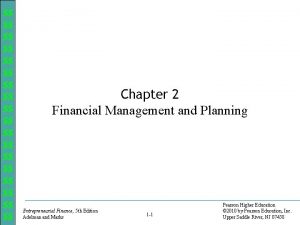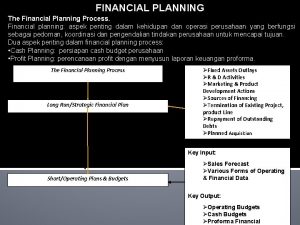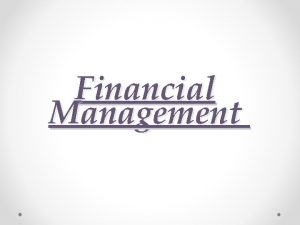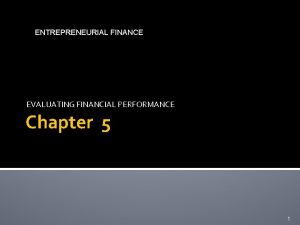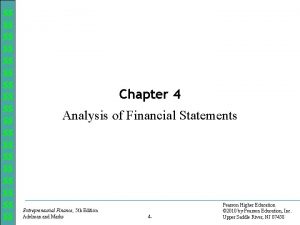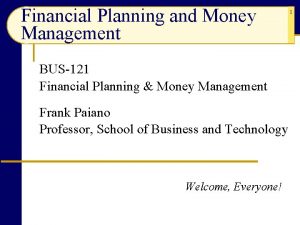Chapter 2 Financial Management and Planning Entrepreneurial Finance



















- Slides: 19

$$ $$ $$ $$ $$ Chapter 2 Financial Management and Planning Entrepreneurial Finance, 4 th Edition By Adelman and Marks 2 - PRENTICE HALL © 2007 by Pearson Education, Inc. Upper Saddle River, NJ 07458

$$ $$ $$ $$ $$ Learning Objectives § Describe the five basic functions of a manager and how they relate to a business. · Distinguish between strategic plans and functional plans. · Understand the three factors that must be addressed when establishing goals. · Describe the financial goals for a for-profit organization. Entrepreneurial Finance, 4 th Edition By Adelman and Marks 2 -2 PRENTICE HALL © 2007 by Pearson Education, Inc. Upper Saddle River, NJ 07458

$$ $$ $$ $$ $$ Learning Objectives (continued) § Trace three-step process that you must take when using control. § Compare and contrast the basic forms of business ownership (sole proprietor, partnership, and corporation). § Distinguish between limited and unlimited liability. § Compare and contrast general partnership, limited partnership, and a limited liability company. Entrepreneurial Finance, 4 th Edition By Adelman and Marks 2 -3 PRENTICE HALL © 2007 by Pearson Education, Inc. Upper Saddle River, NJ 07458

$$ $$ $$ $$ $$ Learning Objectives (continued) § Understand the role that the franchise plays when establishing a business. § Understand the basic components of a SWOT analysis. § Know what basic factors are required to complete a business plan. Entrepreneurial Finance, 4 th Edition By Adelman and Marks 2 -4 PRENTICE HALL © 2007 by Pearson Education, Inc. Upper Saddle River, NJ 07458

$$ $$ $$ $$ $$ Management Functions § Planning is a systematic process that takes us from some current state to some future desired state. › Strategic planning involves establishing an overall plan for the business. › Functional planning is driven by strategic plans and is related to specific functional areas of a business such as accounting, marketing, or human resources. Entrepreneurial Finance, 4 th Edition By Adelman and Marks 2 -5 PRENTICE HALL © 2007 by Pearson Education, Inc. Upper Saddle River, NJ 07458

$$ $$ $$ $$ $$ Management Functions (continued) § Goal setting is precursor to establishing a plan. › Goals must be measurable, achievable, and have a time frame. › Basic financial goals of a for-profit organization: – To maximize the wealth of the business owners (investors) over the life of the business – To meet interest payments on debt – To grow Entrepreneurial Finance, 4 th Edition By Adelman and Marks 2 -6 PRENTICE HALL © 2007 by Pearson Education, Inc. Upper Saddle River, NJ 07458

$$ $$ $$ $$ $$ Management Functions (continued) § Organizing is the second function of the manager and defines the structure of the business. › Who will do it? › What skills do they need? › What is the time frame that we have set in which to have it accomplished? › Where will it be accomplished? › How do we get it accomplished? Entrepreneurial Finance, 4 th Edition By Adelman and Marks 2 -7 PRENTICE HALL © 2007 by Pearson Education, Inc. Upper Saddle River, NJ 07458

$$ $$ $$ $$ $$ Management Functions (continued) § Staffing requires that the manager obtain the most capable personnel to implement the business plans. › Determine job requirements. › Develop a job description. § Directing (leading). Providing proper guidance and direction to others to accomplish the organization’s mission. Entrepreneurial Finance, 4 th Edition By Adelman and Marks 2 -8 PRENTICE HALL © 2007 by Pearson Education, Inc. Upper Saddle River, NJ 07458

$$ $$ $$ $$ $$ Management Functions (continued) § Controlling is a three-step process: 1) Establishing a standard of measurement 2) Measuring actual performance against the standard 3) Taking corrective action when actual performance varies from the established standard Entrepreneurial Finance, 4 th Edition By Adelman and Marks 2 -9 PRENTICE HALL © 2007 by Pearson Education, Inc. Upper Saddle River, NJ 07458

$$ $$ $$ $$ $$ Forms of Business Ownership S O U R C E : I n t e Entrepreneurial r. Finance, n By Adelman and Marks a l 4 th Edition 2 -10 PRENTICE HALL © 2007 by Pearson Education, Inc. Upper Saddle River, NJ 07458

$$ $$ $$ $$ $$ Forms of Business Ownership (continued) § A sole proprietorship is operated by an individual for profit. § A partnership is an association of two or more persons who carry out a business as co-owners for a profit. › General partnership › Limited liability company Entrepreneurial Finance, 4 th Edition By Adelman and Marks 2 -11 PRENTICE HALL © 2007 by Pearson Education, Inc. Upper Saddle River, NJ 07458

$$ $$ $$ $$ $$ Forms of Business Ownership (continued) § The corporation is a legal entity according to U. S. law. › Incorporated in one of the fifty states or territories of the United States. – Public Corporation: stock is sold to the public. – Private Corporation: Stock is not sold to the public. – All corporations are formed as C corporations unless they meet the requirements of and request Subchapter S tax status. • Subchapter S corporation: Private corporation with special tax status granted by Internal Revenue Service (IRS) • Maximum of 100 shareholders • No double taxation Entrepreneurial Finance, 4 th Edition By Adelman and Marks 2 -12 PRENTICE HALL © 2007 by Pearson Education, Inc. Upper Saddle River, NJ 07458

$$ $$ $$ $$ $$ Forms of Business Ownership (continued) § A Limited Liability Company (LLC) is a hybrid business entity having features of both partnerships and corporations. › Taxed as a partnership › Has limited liability for its owners › Flows through income and losses to individual owner’s tax returns Entrepreneurial Finance, 4 th Edition By Adelman and Marks 2 -13 PRENTICE HALL © 2007 by Pearson Education, Inc. Upper Saddle River, NJ 07458

$$ $$ $$ $$ $$ Forms of Business Ownership (continued) § Franchise not an actual form of ownership. A franchise is a business in which the buyer, who is the franchisee, purchases the right to sell the goods or services of the seller, who is the franchiser. Entrepreneurial Finance, 4 th Edition By Adelman and Marks 2 -14 PRENTICE HALL © 2007 by Pearson Education, Inc. Upper Saddle River, NJ 07458

$$ $$ Starting a Business $$ $$ § Run a SWOT analysis $$ › Strengths are the core competencies of a business. They are those factors $$ that will make your business succeed because you perform in these areas $$ better than your competitor. $$ › Weaknesses are those areas of your company that definitely need $$ improvement. $$ › Opportunities are factors that exist outside of your business, but that if taken advantage of, will help your business to grow and prosper (e. g. , low $$ interest rates for business loans). $$ › Threats are factors that exist in the environment that may impede the $$ growth of your business, directly or indirectly (e. g. , new competition). $$ $$ $$ PRENTICE HALL $$ Entrepreneurial Finance, 4 th Edition © 2007 by Pearson Education, Inc. 2 -15 Upper Saddle River, NJ 07458 $$ By Adelman and Marks

$$ $$ $$ $$ $$ Development of a Business Plan § Executive summary: Part of business plan that investors review to determine if they want to read further. Two pages or fewer, the executive summary should contain: › Business strategy for success › Brief description of the market and what makes your business unique › Brief description of the product or service › Brief description of management teams’ qualifications › Summary of revenue and expense projections › Estimate of how much money is needed and how it will be used Entrepreneurial Finance, 4 th Edition By Adelman and Marks 2 -16 PRENTICE HALL © 2007 by Pearson Education, Inc. Upper Saddle River, NJ 07458

$$ Development of a Business Plan $$ (continued) $$ $$ § General Company Description: › Mission Statement: $$ – Company goals $$ – Company objectives – Business philosophy $$ › Form or forms of business ownership $$ › Products and services $$ › Marketing plan – Price $$ – Product $$ – Promotion $$ – Place › Operational plan $$ › Management and organization $$ › Personal financial statement of each owner or major stockholder $$ › Startup expenses and capitalization › Financial plan; a 4 -year projection of profit $$ PRENTICE HALL $$ Entrepreneurial Finance, 4 th Edition © 2007 by Pearson Education, Inc. 2 -17 Upper Saddle River, NJ 07458 $$ By Adelman and Marks

$$ $$ $$ $$ $$ Development of a Business Plan (continued) § Appendices › › › › Brochures, advertising materials, business cards Industry studies Maps and photos of location List of equipment owned or purchased Copies of leases or contracts Letters of support from suppliers and future customers Market research studies List of assets available for a loan Entrepreneurial Finance, 4 th Edition By Adelman and Marks 2 -18 PRENTICE HALL © 2007 by Pearson Education, Inc. Upper Saddle River, NJ 07458

$$ $$ $$ $$ $$ Financing a Business or Raising Capital § Suppliers of funds include lenders and investors › Lenders increase debt and include banks and any other lender › Investors increase company equity and expect a positive return on their investment: – Company owners – Angel investors provide seed money and mentoring to start-up businesses – Venture capitalist normally invests in companies with proven track record Entrepreneurial Finance, 4 th Edition By Adelman and Marks 2 -19 PRENTICE HALL © 2007 by Pearson Education, Inc. Upper Saddle River, NJ 07458
 Chapter 16 money management and financial planning
Chapter 16 money management and financial planning What are some characteristics of a wise money manager
What are some characteristics of a wise money manager Traditional management vs entrepreneurial management
Traditional management vs entrepreneurial management Financial preparation for entrepreneurial ventures
Financial preparation for entrepreneurial ventures Chapter 4 financial decisions and planning
Chapter 4 financial decisions and planning Chapter 4 financial decisions and planning
Chapter 4 financial decisions and planning Long term financial planning and growth chapter 4
Long term financial planning and growth chapter 4 Long term financial planning process
Long term financial planning process Chapter 4 financial decisions and planning
Chapter 4 financial decisions and planning Chapter 4 financial decisions and planning
Chapter 4 financial decisions and planning Chapter 4 financial decisions and planning
Chapter 4 financial decisions and planning Pilbeam k. finance and financial markets
Pilbeam k. finance and financial markets Finance and financial markets keith pilbeam
Finance and financial markets keith pilbeam Chapter 10 financial planning with life insurance
Chapter 10 financial planning with life insurance Chapter 2 personal financial planning answers
Chapter 2 personal financial planning answers Pathways to entrepreneurial ventures
Pathways to entrepreneurial ventures Chapter 33 entrepreneurial concepts
Chapter 33 entrepreneurial concepts Financial management chapter 8 risk and return
Financial management chapter 8 risk and return The process of classifying and reviewing past due accounts
The process of classifying and reviewing past due accounts Neton
Neton





















